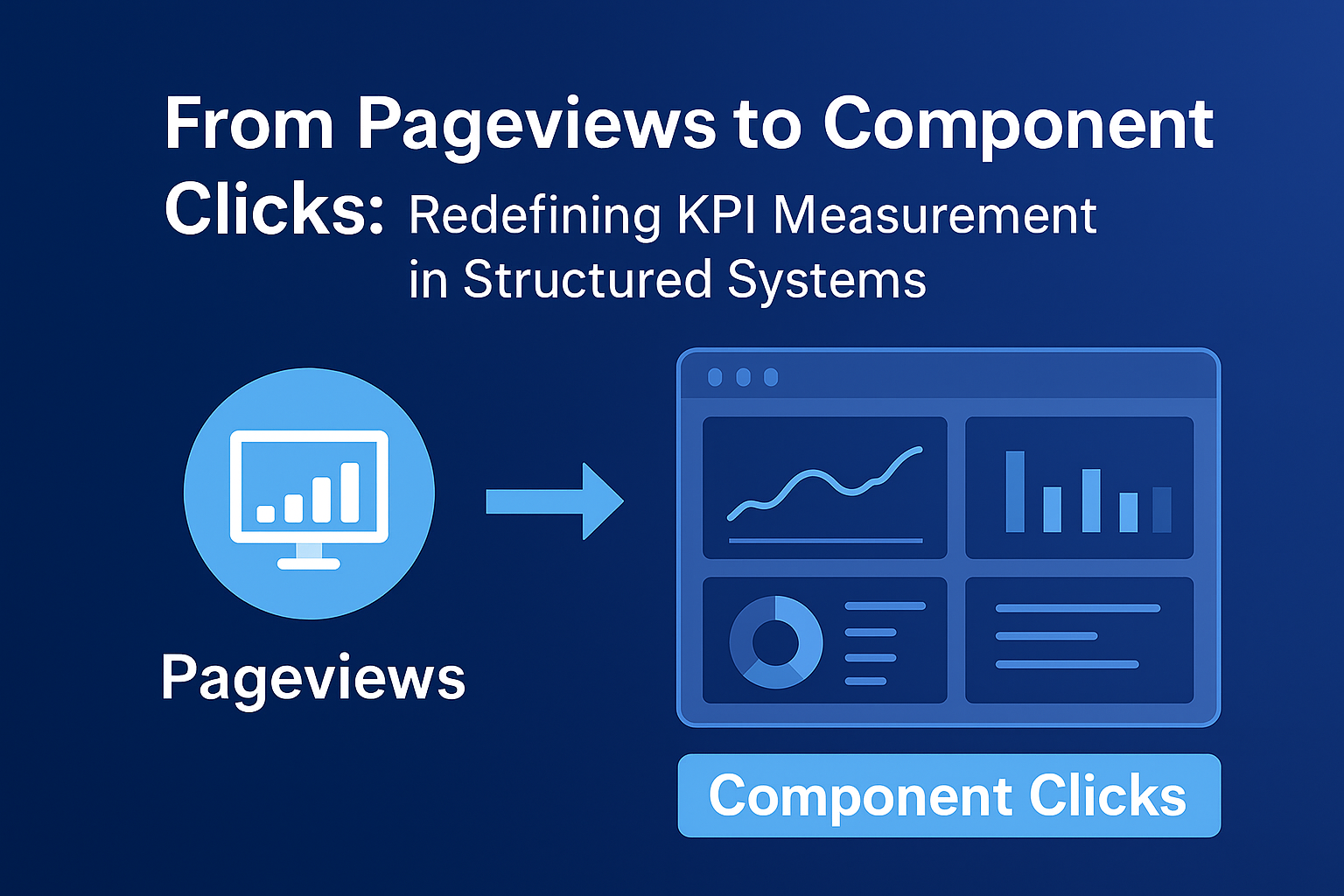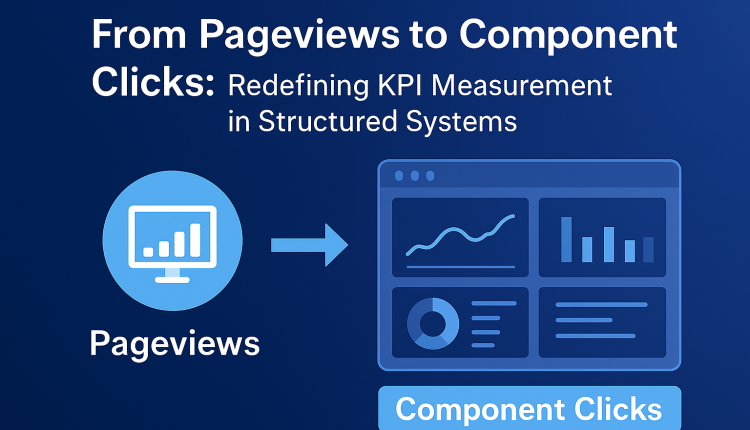From Pageviews to Component Clicks: Redefining KPI Measurement in Structured Systems
Success has traditionally been measured by pageviews. While it’s nice to know something was seen by so many people, a great reach metric does nothing to evaluate how a user engaged with the content or which element on the page made someone take action or respond. Yet this ambiguous metric does not translate in a content ecosystem powered by a headless CMS. In addition, content exists at much more micro, modular levels, so what once was guidance at a page-level becomes guidance at a component level. If businesses can measure clicks, hovers, scrolls, and more at each module, then success can be redefined, and a much fuller understanding of how content facilitates engagement or conversion can be established.

What a Pageview Doesn’t Measure/Assess and Why It’s Bad for Performance
Once upon a time, pageviews were a great proxy for interest. Unfortunately, they don’t help performance anymore. Simply because a visitor loads a page and fails to engage in any modules doesn’t mean that it was successful. The pageview counts and so does the bounce rate. Likewise, time-on-page is a misleading metric. A visitor who stays on the page for a long time might be really invested in what they’re reading or confused and lost, searching for meaning.
When organizations work siloed, aggregate, page-level KPIs only fail to have the opportunity to know what’s working or not. They can’t assess what’s valuable in delivery and they can’t assess whether someone visited ten pages in a row or got all their answers in one page. Headless CMS for developer flexibility enables teams to track and optimize at the component level, giving both marketers and developers precise insights into which modules drive engagement and which need improvement. For organizations that already work with modular systems, it’s even more complicated. There are no victories to be had from measuring a pageview if it comes down to which testimonial or CTA or module for features was so engaging that it manifested interest. When organizations can’t measure at the component level, they’ll have to guess when it comes to optimization and potentially spend double the effort on something that seems engaging because of statistical information behind it but has no real worth behind the scenes.
What Allows For Component Level Measurement What Makes it Possible?
The reason component level measurement is possible through a headless CMS is because these systems take content and convert it to structured data. Content is generated with modular ability from the get-go that allows headlines, images, videos, CTAs to become independent modules. Not to say that they are never integrated, but integration can be measured.
For example, if a CTA is shaped like a button on one landing page, it can also be rendered elsewhere on the site as an independent module stemming from the same CAN (content assembly network). But instead of seeing performance by one page and arbitrary pageviews, marketers can see performance attributes across multiple contexts.
Furthermore, because components are delivered via API, it’s very easy for engagement to be assigned to content ID as part of an actual feedback loop. Without the reliance on vanity metrics, organizations can discover what drives engagement and what doesn’t matter. Structured systems allow for assessing which components can stay, which people need to be changed, and which should never see the light of day again. This allows for better measurements in tandem with what actually happens during creation, execution and consumption of modular content.
New KPIs at the Component Level
Changing from pageviews to component clicks as a measurement means success must be defined differently. It’s no longer, “How many people landed on this page?” But rather, “What components of this page kept people’s attention and motivated them to do.” Component-level KPIs exist since anything is clicked (for a CTA, for engagement with a video block, expansion of an accordion FAQ, etc.).
This makes sense. A page can have many views, but without component-level engagement, it’s clear that people are not engaging with the components designed to help them in the first place. If a module only has a view of 10 but an 100% CTR, then that means it’s valuable content and should be recycled into other areas. When organizations can connect the dots between intent and length of engagement, they can figure out why something works so well and how they can use it for larger gain. Therefore, measurement stemming from component level is a successful integration with the purpose of the structure in mind motivating people to act at the component level.
Component Engagement Throughout the Funnel
Each stage of the funnel relies on different applications. Not only can organizations see what works, but with component-level use, organizations can learn what’s effective at each stage. Awareness components can be measured by whether or not people are using your blog CTAs or social sharing buttons. The consideration step occurs when people engage with comparison components, case studies and pricing features and/or lists/charts. The decision phase is if someone interacts with demo requests, testimonials and/or check-out modules.
When engagement is tracked through the entire journey, organizations can more effectively gauge not only if it works, but how it works throughout the process. This proves that any components are doing what they’re supposed to do: awareness components create awareness, consideration components build effectiveness through learning, and decision components allow for conversion. The improved assessment allows marketers to refine content and journey design opportunities on the fly. It’s no longer about what’s working and reporting back it serves as a map to successful journeys.
Feedback Loops from Component Analytics
Component-level measurement creates a feedback loop that never stops. Instead of measuring engagement just to have it sit in a report, engagement informs iterative creation in the moment. If one block of testimonials gets more engagement than other trust-building options, it needs to be raised up in other campaigns. If engagement with a video module is low, it needs to be changed or scrapped.
This happens naturally in a headless CMS as systems connect via APIs to analytics. For example, once content is created and published, measured performance is reported back to the CMS where components established via structured data can be modified in the moment. This practically merges the measurement and adjustment process to allow for iteration to be part of daily work. Over time, with enough reporting back and processing, these content ecosystems become self-sustaining. Every click generates new signals for design that improve effectiveness in upcoming campaigns. The longer it runs, the better it works.
Ability to Compare Component Performance Across Channels
Content doesn’t always exist in a vacuum, but rather, the same modules are used across channels, web and apps, email and landing pages, social ads, etc. Thus, component-level analytics allow enterprises to compare effectiveness across engagements. A CTA might perform exceptionally well in a mobile app but gets fewer clicks when replicated on a page accessed through a desktop. A video block might thrive in social media but gain no clicks when it’s placed on a dedicated landing page.
With access to track performance across channels, marketers can adjust tactics to make sure every component/module works to its best abilities. Instead of thinking that underperformance is a failure, they can readjust content where it works best. This is possible through structured systems because while components function in silos, they are also deployed widely. Through API connections, the tracking is consistently done across channels so the view is comprehensive no matter where clients may connect. This ensures optimization is based on where content works best for every situation through researched data input that champions effective change across the entire customer journey.
Governance and Accountability when Redefining KPIs
Wherever measurement becomes focused, governance is necessary to ensure measurement is reliable and valuable. Component-level analytics must be consistent enough that a click is a click, not only across a module but also in its corresponding social channel. More tracking without governance breeds insights that suggest disjointed activity, lost in translation about what something means across the different channels or modules. Silos are created and data is not trusted.
Yet the opportunities of headless CMS for governance allow for standard operating procedures to be established for the common good without hindering opportunity. For example, required fields, content IDs or event tracking tags are required across the board within all modules, providing consistent qualifiers for comparison. Access and action qualifiers ensure those who have the ability to change measurement also have the opportunity to do so. Thus, chaos doesn’t ensue while the opportunity for iteration exists. Governance allows the opportunity to redefine KPIs from tactical to strategic as teams and organizations can trust that component analytics are scalable even internationally across teams and campaigns without losing meaning or dependability.
AI is the Next Gen of KPI Measurement.
But the next generation of KPI measurement comes from the power of AI. Where analytics can tell you what your audience did, AI can essentially reveal what they’ll do next. Machine learning can trigger a quantification of activity across millions of components to determine which super components yield positive results first and fastest.
For example, if millions of users engaged with the same video, visited a comparison chart, and clicked an analogous CTA once, alpha tracking will show that this sequence of activity suggests that a user is 75% more likely to convert. This is information that provides organizations interest and value creating content models that emphasize this chain of activity as important to all channels, for example. Predictive KPIs shift the focus from measurement and reporting to champion lagging activity in defense to proactive strategy, giving campaigns the ability to pivot in real time before seeing decreases. When systems are organized for content modularization and data overflow, AI can transform analytics into a crystal ball that ensures KPI measurement keeps alignment with audience expectations and technological tactical evolution.
Conclusion
Switching from measuring success via pageviews to component clicks is a new approach to assessing content-driven success. The ability to have a governed process through a headless CMS framework means that such minutia is not only possible but required to determine exactly what gets people in the door, to begin with. When you can track a click through the entire process, when you can see where the feedback options were presented (and either not clicked on or provided feedback) and compare how other sections/channels did, and where more governance is necessary, the likelihood of success is higher. Furthermore, with artificial intelligence, key performance indicators will be predictive; thus, relying on gut and aggregate vanity metrics will be unhelpful. Understanding what constitutes new success will be predicated upon the ability to assess after the fact based on what users did instead of what they said they would do. This new reality takes every click as a sign instead of an engagement.

Comments are closed.